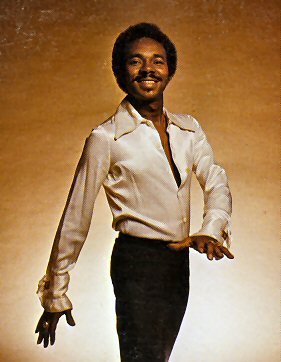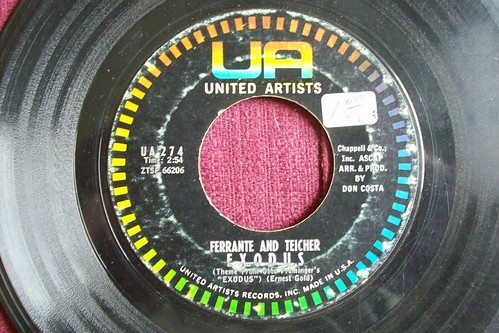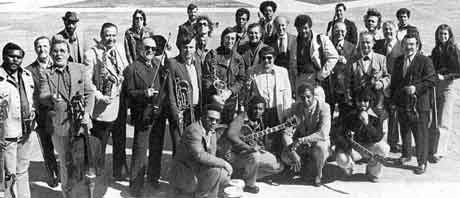You will find several lists of the top instrumentals so this one is far from being the only one. It is, however, unique in that I tried to base it on what the public thinks, leaving my personal bias out of it. For it doesn't matter what a so-called "expert" or professional in the music business thinks. History will always record what the public likes.
So I base a good deal of this list on chart performance at the time, single and album sales to this point in history, and how the song holds up today. I have put a considerable amount of time and effort into coming up with this list.
What is great about instrumentals is that the songwriter is free to focus solely on the music. Artists today have gotten away from that--when you strip the song from its jive and 21st century sound effects, all you have is the music. By listening to these instrumentals, hopefully we'll get back to what matters when composing a song.
Of course, I do realize that beginning in the 1980's, we as a society began cutting music programs to the bone so really we have only ourselves to blame for the poor quality of "music" these days. I know my own knowledge of music (I play the saxophone, clarinet and have played piano since age 5 and was in a group of 12 that was selected to sing at our church's world conference in Portland, Oregon and then toured throughout the country...) would not have been as great were it not for music education in the schools. I hope we can get back to providing more funds for that, to stimulate our children's interest in music.
Getting back to the other "lists" you may see on the web. They are great, but what is a music site without music?! Thus, you actually get to hear the songs that are in the list. Many I was not familiar with until I started researching for this special.
For navigation, the song titles are below the embedded YouTube video. For ease of use, I have separated the list into 10 segments of 10 songs each. I strongly recommend playing each song in order--with any luck (if I've done my homework (and I have!)), each one should sound better than the last. At least that's the goal.
The Top 10 Instrumentals of the Rock Era* will appear July 24. Here now, numbers 20 through 11--
20. "The Hustle", by Van McCoy
McCoy came up with the song after popular line and partner forms of a dance called "The Hustle" emerged. The partner form of the dance is usually called "The New York Hustle" or "The Latin Hustle". The cast of the movie "Saturday Night Fever" came up with "The Tango Hustle". Up against songs like "Listen to What the Man Said", "Jive Talkin'", "One of These Nights" and "I'm Not in Love", McCoy's song reached #1 on July 26, 1975. It was #2 for two weeks on the Adult Contemporary chart, went gold and won a Grammy Award for Best Pop Instrumental Performance.

McCoy has over 700 copyrights to his credit as a writer, co-writer or arranger. He was the lead singer and songwriter of the Starlighters for a brief time. McCoy was then hired as a staff writer at Scepter Records, writing songs for Aretha Franklin, Roberta Flack, Nat King Cole, Gladys Knight & the Pips, Tom Jones, the Shirelles, Chad & Jeremy, Ruby and the Romantics, Nancy Wilson, Barbara Lewis and others.
19. "A Fifth of Beethoven" by the Walter Murphy Band

"A Fifth of Beethoven" was adapted from Beethoven's "5th Symphony". Murphy played nearly every instrument on the song but was inexplicably forced by his record label to credit it to an imaginary ensemble. "A Fifth of Beethoven" reached #1 on the popular chart, sold over a million copies and remained a best-seller for 28 weeks. It didn't hurt that the song was later included on the blockbuster "Saturday Night Fever" Soundtrack.

Murphy took piano and organ lessons at the age of four. He studied both Classical and Jazz music piano at the Manhattan School of Music. He worked for a while as the arranger for Doc Severinson and "The Tonight Show" band. In the early 70's, Murphy wrote advertising jingles for Revlon and Woolworth's, among others.
18. "Exodus" by Ferrante & Teicher

"Exodus" is the theme song from the movie starring Paul Newman. It was written by Ernest Gold and won a Grammy Award for Song of the Year (The score to the movie by Gold also won an Academy Award for Best Original Score.) Ferrante & Teicher reached #2 in 1960 with the song, which sold over a million copies.

Ferrante & Teicher were one of the best-selling Easy Listening acts of the 1960's. They played to packed concert houses, performing up to 100 times a year at their peak. They posted 10 Top 10 hits over a 13-year period.
17. "A Taste of Honey" by Herb Alpert & the Tijuana Brass

Ferrante & Teicher were one of the best-selling Easy Listening acts of the 1960's. They played to packed concert houses, performing up to 100 times a year at their peak. They posted 10 Top 10 hits over a 13-year period.
17. "A Taste of Honey" by Herb Alpert & the Tijuana Brass
Bobby Scott and Ric Marlow wrote "A Taste of Honey" as a theme to a Shelagh Delaney play that was made into a movie in 1961. Martin Denny recorded the song and won a Grammy for Best Instrumental Theme. In 1966, Alpert and the Tijuana Brass recorded the song and reached #1 for five weeks on the Easy Listening Chart and #7 on the Popular chart. Alpert won Grammys Please Please Me.

Alpert and his wife Lani Hall donated $30 million to UCLA to form and endow the UCLA Herb Alpert School of Music. They gave $24 million to CalArts
16. "Joy" by Apollo 100
"Joy" was based on "Jesu, Joy of Man's Desiring" by Johann Sebastian Bach. British Jigsaw (later shortened to Jigsaw, who had the hit "Sky High" in 1975), originally recorded the song on their album in 1970. Apollo 100 remade the song and it reached #6 in 1972.

Apollo 100 was a British studio group formed by arranger and multi-instrumentalist Tom Parker. The group concentrated on light classical pieces on two albums in the early 70's.
15. "Gonna' Fly Now" by Maynard Ferguson
"Gonna' Fly Now" is of course the theme from the blockbuster movie "Rocky" starring Sylvester Stallone and Burgess Meredith. Bill Conti did the music for the soundtrack and enough stations played that version to take it to #1 on Billboard's chart. The reality is that most radio stations (and far more people) preferred the "jazzed-up" version of the song by Maynard Ferguson, but the record company took too long to release it, and of course a station couldn't play two versions of the same song when people were already tired of the Conti version.

Ferguson was playing piano and violin by age four. At age nine, he heard a cornet and began playing that as well. By 13, Ferguson soloed with the Canadian Broadcasting Corporation Orchestra. Ferguson won a scholarship to the Conservatoire de musique du Quebec a Montreal.

Ferguson began playing in Stan Keaton's orchestra, and played alongside Doc Severinson in the Charlie Barnet Band before forming his own band in 1957. In 1950, 1951 and 1952, Ferguson won the Down Beat Readers' Poll as best trumpeter. Ferguson could play an incredibly high register (the high-high notes!). He became a session player for Paramount Pictures and played on 46 soundtracks including "The Ten Commandments".
14. "Nadia's Theme" by Barry DeVorzon and Perry Botkin, Jr.

This song (originally titled "Cotton's Dream" and including lyrics) was written by Barry DeVorzon and Perry Botkin, Jr. for the movie "Bless the Beasts and the Children". Two years later, the pair rearranged the song for the television soap opera "The Young and the Restless", which used it as its theme beginning March 26, 1973. The song was renamed "Nadia's Theme" when ABC television requested it as the background for a montage they were putting together of Romanian gymnast Nadia Comaneci. Comaneci so captured the world's attention with her perfect "10" routines in the 1976 Summer Olympics that A&M Records decided to release the single a month later as "Nadia's Theme".
"Nadia's Theme" reached #8 on both the popular chart and the Adult Contemporary chart, sold over a million copies and won a Grammy Award for Best Instrumental Arrangement.

DeVorzon worked with Marty Robbins, Dorsey and Johnny Burnette. He founded Valiant Records in the mid-60's and signed the Association to his label. DeVorzon also wrote the "Theme from S.W.A.T.", which we have already heard in The Top 100 Instrumentals*, and co-wrote "In the City" for the movie "The Warriors" with Joe Walsh. Devorzon and Botkin together wrote "Bless the Beasts and the Children" for the Carpenters, which received an Academy Award nomination.

Botkin worked as an arranger with Barbra Streisand, Carly Simon, Bobby Darin, Harry Nilsson, the Lettermen, Ed Ames, Harpers Bizarre, the Cascades ("Rhythm of the Rain"), Jose Feliciano ("Feliz Navidad") and others.
13. "Theme From 'Romeo & Juliet'" by Henry Mancini

The song, also known as "A Time for Us" is from the movie "Romeo & Juliet", which starred Leonard Whiting and Olivia Hussey. The song began competing for airplay on a Florida radio station with songs by the Beatles and Rolling Stones and gradually, more stations played it. The record company was forced to release the song as a single and it topped the popular chart for two weeks and the Easy Listening chart for eight weeks.

Mancini composed music "Breakfast at Tiffany's", the powerful movie "Days of Wine and Roses" starring Jack Lemmon, the great movie "Silver Streak", for all the "Pink Panther" movies starring Peter Sellers, and dozens of others. Mancini was nominated for an unprecedented 72 Grammys, winning 20, was nominated for 18 Academy Awards, winning four, and also won a Golden Globe Award and was nominated for two Emmys.
12. "TSOP" by MFSB and the Three Degrees
"TSOP" was the theme of the popular television show "Soul Train" for years and was the first disco song to reach #1. There are two vocal parts of the song performed by the Three Degrees but the song is considered an instrumental. "TSOP" reached #1 for two weeks, was #1 on the R&B chart for a week and #1 on the Adult Contemporary chart for two weeks.

MFSB Record producers Kenny Gamble and Leon Huff assembled a group of about 30 studio musicians that became known as MFSB, which stood for Mother, Father, Sister, Brother (not that the musicians were related but that they were connected musically). In 1978, MFSB recorded a cover of "K-Jee", which was featured in a prominent scene of the blockbuster movie "Saturday Night Fever".
11. "Green Onions" by Booker T. & the MG's

Booker T & the MG's composed music for this 45 while waiting for a Sun Recording artist to show up for a session. They wrote a blues song called "Behave Yourself". The studio engineer (Jim Stewart) liked the song and wanted to put it out on a 45. They of course needed something to put on the flip side The group decided to play one of the songs Booker T (age 17 at the time) had been playing on piano but using the Hammond M3 organ instead. That way, both songs would feature the Hammond. That song would be known as "Green Onions". The group brought the song to WLOK in Washington, D.C. the day after recording it. DJ's ignored the A-side and played "Green Onions" instead. Subsequent pressings had "Green Onions" as the A-side.
"Green Onions" reached #3 in 1962 and sold over a million copies.
"Green Onions" reached #3 in 1962 and sold over a million copies.

Booker T and the MG's (MG of course stands for the famous sports car but to avoid legal problems the group said that it stood for "Memphis Group") recorded with all the greats on the Stax label, including Wilson Pickett, Otis Redding and Isaac Hayes, but they also recorded their own music in between sessions. The group consisted of Booker T. Jones, Steve Cropper, Al Jackson and Lewie Steinberg. Steinberg was replaced in 1964 by Donald "Duck" Dunn.
No comments:
Post a Comment
Note: Only a member of this blog may post a comment.